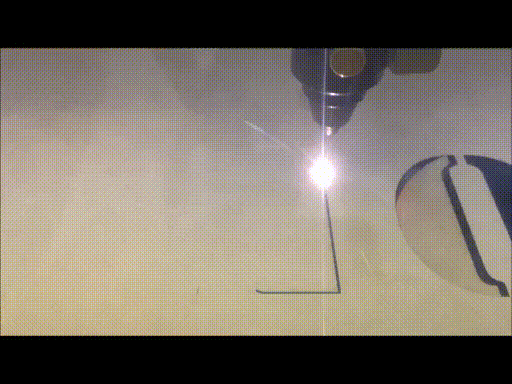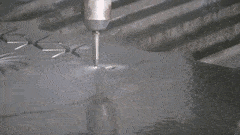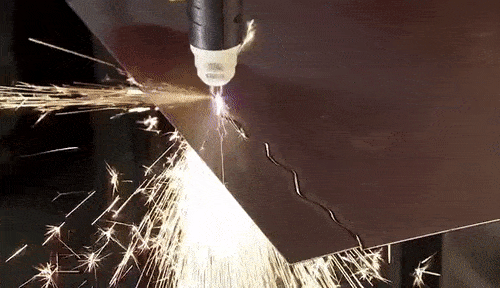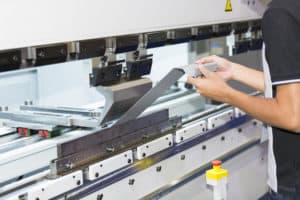Sheet metal fabrication is the process of turning flat sheet metals, typically 0.15 mm to 10 mm thick, into parts and structures of various shapes. The stock materials for this process are flat metal sheets. Sheet metal fabrication is used to create objects such as enclosures, chassis, brackets, stamped features, curls, etc. It is also used for decorative purposes to make patterns in metal sheets.
How Does Sheet Metal Fabrication Work?
The transition from stock material to the finished product usually requires one or more of the following three processes: material removal (cutting), deforming, and assembly. If all these processes are required, they are usually performed chronologically.
Material Removal
This involves cutting out pieces of the stock material to produce the desired shape. For maximum accuracy, speed, and efficiency CNC waterjet, plasma, and laser cutting technologies are usually employed. EDM (electrical discharge machining) could be also an option in some cases.
Laser Cutting
In laser cutting, a high-density laser beam is directed onto a workpiece to melt, vaporise, or burn through it, effectively cutting the material. Laser cutters are used for cutting, boring, and engraving. There are three types of lasers used in laser cutting; CO2 (carbon dioxide), Nd (neodymium), Nd:YAG (neodymium-doped yttrium aluminium garnet).
CO2 lasers have high energy efficiency and high power output ratio, and are used for cutting thin material, engraving, and boring. Nd lasers have high energy but low repetition efficiency. They are used for engraving, boring, and welding. Nd:YAG lasers have a very high power output and can cut thicker materials. However, they are more expensive to operate than CO2.

Laser cutters can work with aluminum, steel, copper, stainless steel, and other metals. They are best used for cutting thin workpieces (maximum thickness of 15 mm for aluminium and 6 mm for steel), engraving, and boring
Waterjet Cutting
In waterjet cutting, a nozzle is used to focus a jet of water at very high pressures to cut a workpiece. For relatively soft material like rubber and wood, only water is used. A mixture of water and abrasive granular substances is used to cut harder material such as metals.

Waterjet cutting can cut material of various thicknesses. The maximum thickness that can be cut depends on the material. Of all CNC cutting methods, waterjet cutting is the most precise with tolerances between 0.05 mm and 0.1 mm. One of the reasons for its high precision is that unlike plasma and laser counterparts, waterjet cutting does not generate heat hence there is no heat affected zone in the workpiece.
Waterjet cutting is very versatile as it is used to cut hard material such as aluminum, steel, copper, stainless steel, and other metal alloys as well as softer materials like polymers, elastomers, wood, and foam.
Plasma Cutting
Plasma cutting works by applying heat and energy to a gas to turn it to plasma. A jet of hot plasma is then accelerated using an inert gas or air, out of the cutting nozzle and onto the workpiece. The plasma completes an electrical arc with the workpiece, melting and cutting it. Being an electrical process, plasma cutters only work with electrically conductive material.

Plasma cutters can cut through very thick material, up to 300 mm for aluminum and 200 mm for steel, with a tolerance of 0.2 mm. Other materials that are processed using plasma cutters are stainless steel, copper, and other metal alloys. Depending on the complexity of the part to be produced, 2-axis or 3-axis cutters may be used.
Although plasma cutters are not as diverse or precise as waterjet and laser cutters, they are the best choice for thick electrically conductive metal parts, as they are faster and more cost-effective for cutting such materials.
Deforming
This process is the controlled application of force to bend or form sheets into desired shapes. Deforming processes included bending, forming, stamping, and stretching using dies as well as hydraulic and magnetic brakes.

Assembling
This is the process of joining various processed workpieces together to form a final product. Assembling processes include welding, brazing, riveting, and sometimes, the use of adhesives.
Materials
The most suitable metals for this process are aluminium and its alloys, steel, copper and its alloys, and stainless steel. The table below contains the most popular metal grades for sheet metal fabrication.
| Aluminium | Copper | Stainless steel | Steel |
| DIN 3.3523 | EN AW5052 | DIN 2.0065 | EN CW004A | 1.4319 | Mild steel |
| DIN 3.3211 | EN AW6061 | DIN 2.0265 | EN CW505L | 1.4301 | Low-carbon steel |
| DIN 3.3535 | EN AW5754 | DIN EN 13601 | EN CW009A | 1.4404 |
Post-processing Operations
Common post-processing operations used in sheet metal fabrication are bead blasting, anodizing, powder coating, and painting. For deformed or welded materials, heat treatment is carried out to relieve residual stresses.
Benefits of Sheet Metal Fabrication
Some of the benefits of sheet metal fabrication are as follows.
- Durability: The process produces highly durable products for both prototyping and end-use
- Scalability and cost-efficiency: Whether you need a single one-off part or a production run of thousands of parts, sheet metal fabrication provides a fast and cost-effective solution.
- Material selection: Numerous metals can be processed via this method of fabrication. You can choose from hundreds of metals with varying desirable properties.
- Rapid turnaround: The use of CNC technologies for sheet metal fabrication makes the process fast and effective
Industries that Employ Sheet Metal Fabrication
Any industry that makes use of metal parts would likely find the need for sheet metal fabrication. Some of the industries which employ the process are
- Machine building
- Engineering and design
- Metalworks
- Electronics
- Furniture and city infrastructure
- Robotics
- Medical and healthcare
- Automotive
- Musical instruments
- Civil construction
Conclusion
At Xometry Asia we offer high-precision, fast and quality sheet metal fabrication services for the creation of parts out of sheet metal such as aluminium, steel, copper alloys and many others. Using automated cutting technologies such as CNC laser cutting, plasma cutting, water-jet cutting as well as deforming and assembling technologies, we guarantee high precision and quality of ready parts.
We also carry out post-processing upon your request. To get an instant quote, upload your models on our Instant Quoting Engine.